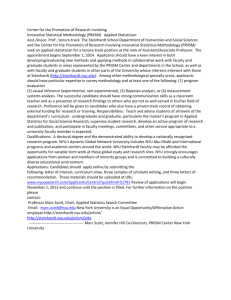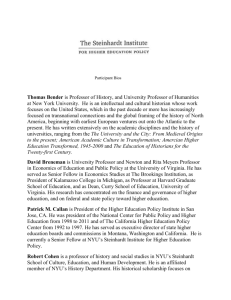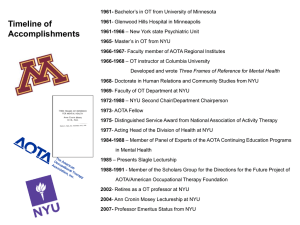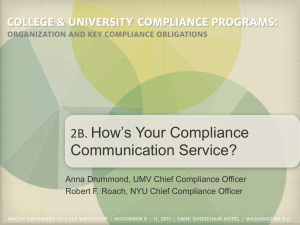Syllabus: E33.2244 Food Sociology: Social
advertisement
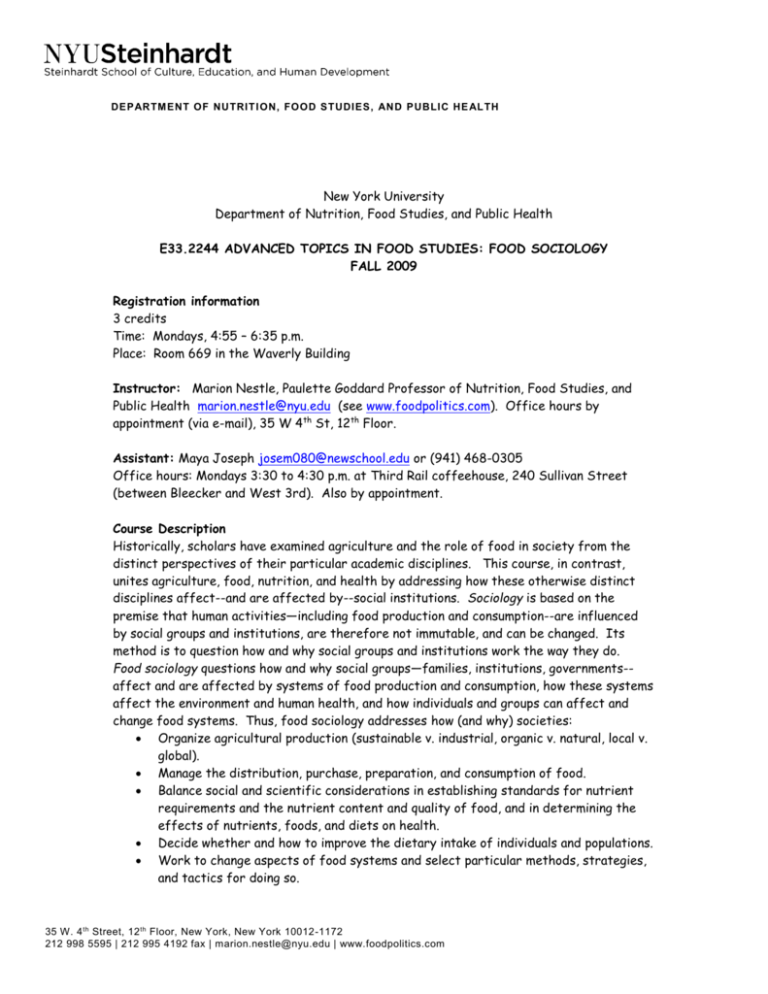
DEP ARTM ENT OF NUTRI TI ON, FOOD STUDIES, AND PUBLIC HE AL TH
New York University
Department of Nutrition, Food Studies, and Public Health
E33.2244 ADVANCED TOPICS IN FOOD STUDIES: FOOD SOCIOLOGY
FALL 2009
Registration information
3 credits
Time: Mondays, 4:55 – 6:35 p.m.
Place: Room 669 in the Waverly Building
Instructor: Marion Nestle, Paulette Goddard Professor of Nutrition, Food Studies, and
Public Health marion.nestle@nyu.edu (see www.foodpolitics.com). Office hours by
appointment (via e-mail), 35 W 4th St, 12th Floor.
Assistant: Maya Joseph josem080@newschool.edu or (941) 468-0305
Office hours: Mondays 3:30 to 4:30 p.m. at Third Rail coffeehouse, 240 Sullivan Street
(between Bleecker and West 3rd). Also by appointment.
Course Description
Historically, scholars have examined agriculture and the role of food in society from the
distinct perspectives of their particular academic disciplines. This course, in contrast,
unites agriculture, food, nutrition, and health by addressing how these otherwise distinct
disciplines affect--and are affected by--social institutions. Sociology is based on the
premise that human activities—including food production and consumption--are influenced
by social groups and institutions, are therefore not immutable, and can be changed. Its
method is to question how and why social groups and institutions work the way they do.
Food sociology questions how and why social groups—families, institutions, governments-affect and are affected by systems of food production and consumption, how these systems
affect the environment and human health, and how individuals and groups can affect and
change food systems. Thus, food sociology addresses how (and why) societies:
Organize agricultural production (sustainable v. industrial, organic v. natural, local v.
global).
Manage the distribution, purchase, preparation, and consumption of food.
Balance social and scientific considerations in establishing standards for nutrient
requirements and the nutrient content and quality of food, and in determining the
effects of nutrients, foods, and diets on health.
Decide whether and how to improve the dietary intake of individuals and populations.
Work to change aspects of food systems and select particular methods, strategies,
and tactics for doing so.
35 W. 4 th Street, 12 th Floor, New York, New York 10012-1172
212 998 5595 | 212 995 4192 fax | marion.nestle@nyu.edu | www.foodpolitics.com
From the perspective of food sociology, food becomes the medium through which to ask
fundamental questions about the nature and values of modern social institutions. If, as
many believe, the goal of sociology is to describe human society so as to improve human
welfare, the goal of food sociology is to describe systems of food production and
consumption in order to improve dietary intake, the environment, and human health.
Today, such matters are of great public and professional interest. Indeed, interest in food
is so widespread that efforts to improve food systems are considered by some to
constitute a social movement. If so, food sociology seeks to describe this movement, and to
ask why it is occurring at this moment in history, which social groups hold a stake in its
outcome, and how social groups and institutions influence its development and outcome. This
course focuses on such questions.
Readings
All students are expected to do all the reading for every class, to try to make sense of it,
and to come to class with thoughts, comments, and questions.
Books: The course requires extensive reading as a basis for class discussion. These are
listed in the outline under Assignments. Most have been published within the last year or so
and represent distinct, current points of view.
Papers: Additional required readings are posted on Blackboard or linked to the Internet.
Newspaper: Read a daily paper of your choice—in hard copy or online—to keep up with
current events related to class topics.
Evaluation
1. Class participation and presentations (40%): This class will be run as a seminar, not a
lecture course. Participation in discussions is essential. All students will be expected to
provide comments in class on all assigned readings. In every class session, a few students
will assume primary or secondary responsibility for summarizing key issues in the readings
and generating questions for class discussion (this will be organized during the first class).
Presentations—aim for 5 to 7 minutes—should explain in your own words what you think the
readings mean or what you found particularly interesting, difficult, or absurd. In preparing
your presentation, assume that students have done the reading. Do not—under any
circumstances—waste class time by summarizing the material. Summaries will get very bad
grades. Engaging with the material—even if it’s just to explain why you hate it or don’t
understand it—will produce high marks for this assignment.
34 Stuyvesant Street | New York, New York 10003 -7599
212 998 5700 | 212 995 4320 fax | steinhardt.art@nyu.edu | www.steinhardt.nyu.edu/art
2. Term paper (60%): Students will write a term paper on a topic to be developed in
consultation with instructors. Papers should be about 15 pages of text (double spaced).
Additional pages can be used for references (required); an annotated list of Internet and
library sources (required); and tables, figures, or appendices (optional). Papers are
expected to be presented in standard format for research term papers. If you are not
sure how to do this, ask. They must produce evidence of serious research into library and
Internet sources. They must not be plagiarized (an issue to be discussed in class).
Note key dates:
On October 26 and November 2, class time will be set aside for students to
present brief summaries of their proposed term papers.
By November 23, make sure you have seen two movies, Food, Inc and Fresh.
On December 7, there will be an opportunity for brief summary presentations of
key issues and findings from term papers.
DUE: December 18, 5:00 p.m.
34 Stuyvesant Street | New York, New York 10003 -7599
212 998 5700 | 212 995 4320 fax | steinhardt.art@nyu.edu | www.steinhardt.nyu.edu/art
COURSE OUTLINE
CLASS
TOPIC
ASSIGNMENTS
September
14
Introduction and
overview
September
21
Social movements:
theoretical approaches
Pollan M. Letter to farmer in chief, New York Times, October 9,
2008
http://www.nytimes.com/2008/10/12/magazine/12policy-t.html
Freeman J. Resource mobilization and strategy: a model for
analyzing social movement organization actions. In: Zald MN,
McCarthy JD. The Dynamics of Social Movements: Resource
Mobilization, Social Control, and Tactics. Winthrop, 1979:167-189.
Giugni M. How social movements matter: past research, present
problems, future developments. In: Giugni M, McAdam D, Tilly D,
eds. How Social Movements Matter. U. Minnesota, 1999:xiii-xxxiii.
Stewart CJ, Smith CA, Denton RE. The social movement as a
unique collective phenomenon. In: Persuasion and Social
Movements, 4th ed. Waveland, 2001:1-25
Best J. Introduction: Typification and social problems
construction. In: Images of Issues: Typifying Contemporary Social
Problems. Aldine de Gruyter, 1989:xv-xxii.
Sobal J, Maurer D. Food, eating, and nutrition as social problems.
In: Eating Agendas: Food and Nutrition as Social Problems. Aldine
de Gruyter, 1995: 1-7.
Bonanno A, Constance DH. Agency and resistance in the sociology
of agriculture and food. In: Wright W, Middendorf G, eds. The
Fight Over Food: Producers, Consumers, and Activists Challenge
the Global Food System. Pennsylvania State, 2008:29-43.
34 Stuyvesant Street | New York, New York 10003 -7599
212 998 5700 | 212 995 4320 fax | steinhardt.art@nyu.edu | www.steinhardt.nyu.edu/art
September
28
Food social
movements:
theoretical approaches
Friedland WH. Agency and the agrifood system. In: Wright W,
Middendorf G, eds. The Fight Over Food: Producers, Consumers,
and Activists Challenge the Global Food System.
Pennsylvania State, 2008:45-67.
Gottlieb R. The politics of food: agendas and movements for
change. In: Environmentalism Unbound: Exploring New Pathways
for Change. MIT Press, 2001:227-272.
McIntosh WA. Food and social change. In:Sociologies of Food and
Nutrition. Plenum, 1996:175-194.
Stevenson GW, Ruhf K, Lezberg S, Clancy K. Warrior, Builder, and
Weaver Work: Strategies for Changing the Food System. In:
Hinrichs CC, Lyson TA, eds. Remaking the North American Food
System. U. Nebraska Press, 2007: 33-62.
Germov J, Williams L. Exploring the Social Appetite. In: A
Sociology of Food & Nutrition. Oxford, 2008:3-10.
October 5
October 12
The food security
movement: theoretical
perspectives
The food security
movement: practical
perspectives
October 19
Maya Joseph
The safe food
movement: science
versus dread and
outrage
October 26
The local food
movement
Albritton R. Let Them Eat Junk: How Capitalism Creates Hunger
and Obesity. Pluto Press, 2009.
Winne M. Closing the Food Gap: Resetting the Table in the Land of
Plenty. Beacon Press, 2008.
Submit preliminary ideas for term paper topics.
Nestle M. Pet Food Politics: The Chihuahua in the Coal Mine.
University of California Press, 2008.
Carpenter N. Farm City: The Education of an Urban Farmer.
Penguin, 2009.
Half the class presents topics for proposed term papers.
34 Stuyvesant Street | New York, New York 10003 -7599
212 998 5700 | 212 995 4320 fax | steinhardt.art@nyu.edu | www.steinhardt.nyu.edu/art
November 2
The anti-obesity
movement
Popkin B. The World is Fat: The Fads, Trends, Policies, and
Products that are Fattening the Human Race. Avery, 2009.
or
Cardullo H. Stuffed: An Insider’s Look at Who’s {Really} Making
America Fat. Ecco, 2009.
Half the class presents topics for proposed term papers.
November 9
The farm animal
welfare movement
Pew Commission report on industrial farm animal production
http://www.ncifap.org/_images/PCIFAPFin.pdf
November 16
The water resources
movement
Plagiarism case study (on Blackboard)
Royte E. Bottlemania: How Water Went on Sale and Why We
Bought It. Bloomsbury, 2008.
November 23
The good, clean, fair
food movement
Weber K, ed. Food, Inc.: How Industrial Food is Making Us Sicker,
Fatter, and Poorer—And What You Can Do About It. Public
Affairs, 2009.
By this class, see movies: Food, Inc.; Fresh
November 30
Food advocacy
FTC report on food marketing to children
http://www.ftc.gov/os/2008/07/P064504foodmktingreport.pdf
Simon, Michele. Appetite for Profit: How the Food Industry
Undermines Our Health and How to Fight Back. Nation Books,
2006
Smith B, Costello T, Brecher J. Social movements 2.0. The Nation,
January 15, 2009 at
http://www.thenation.com/doc/20090202/smith_costello_brecher.
December 7
December 18,
5:00 p.m.
Student presentations
Term papers due
34 Stuyvesant Street | New York, New York 10003 -7599
212 998 5700 | 212 995 4320 fax | steinhardt.art@nyu.edu | www.steinhardt.nyu.edu/art
